
Cedar Gallery
Home
|
Cedar info |
News |
Contact |
![]() Dutch
Dutch


A.W. April 2010
Photo's: Cees & Aly Wagenvoorde
©PAM PHOTOS Delden
©.All Rights Reserved. NO!- Neither Facebook and
Instagram nor any other visitor may use my name or any of my content
without my permission.
You can contact me at
cedars@live.nl
- - - - - - - - - - - - - - - - - - - - - -
- - - - - - - - - - - - - - - - - - - - - - - - - - - - - - - - -
HISTORY - DECEMBRISTS - IRKUTSK TODAY - THE TRANS-SIBERIAN RAILROAD - FAMOUS PERSONS - ARCHITECTURE, WOODEN HOUSES - LAKE BAIKAL
History
Wide and free, the vast landmass of Siberia lies behind the Ural
mountains. For many centuries, not only for foreign travelers but also
for Russians themselves, Siberia seemed to be "unknown territory",
unsafe and barbaric.
Irkutsk was founded as a military outpost in 1652. In 1686 there was a
church and a small town established on the banks of the Angara. Tea
caravans from China passed through Irkutsk, fur traders sold their pelts
here and the town developed. Pioneers, Cossacks, missionaries,
deportees, rich - each of these added to the glory of this city -
Irkutsk.
By the beginning of the 19th-century Irkutsk was Siberia’s
administrative capital. The Governor, who lived in the elegant white
building that still stands by the river (opposite the statue of
Alexander III), presided over an area 20 times the size of France.

 Alexander III
Alexander III
The White House (see architecture below)
The mellow chime of hundreds of bells met Irkutsk's guests, at the
beginning of the twentieth century. There were about forty Orthodox
churches in Irkutsk in those days, not all of which have survived to the
present.
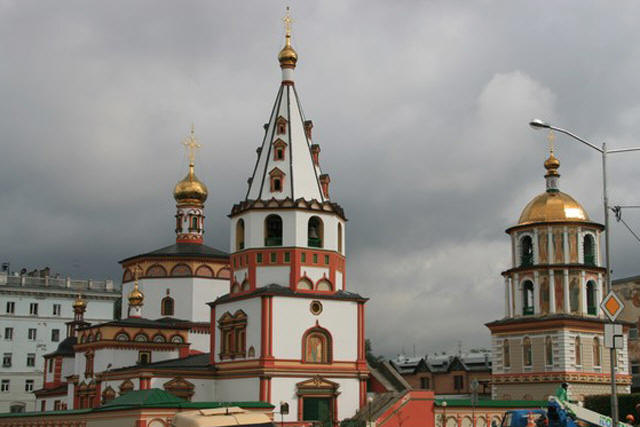


For three and a half centuries Irkutsk has lived a long-suffering life,
undergoing many severe trials. The worst of these trials may have been
in the so-called "Black Year" of 1879, which was marked by a devastating
fire. Three days and nights the city was a blazing inferno, the fire
destroyed 75 % of the houses, and ten long years were needed to rebuild
it! People from all over Siberia and Russia raised it anew from the
ashes, and after ten years A.P.Chehov could say: "The city of Irkutsk is
dandy. It is quite a European city...."
With the discovery of gold in the area in the early 19th
century, the cosmopolitan population increased, and included fur
traders, tea merchants, gold prospectors, exiles and ex-convicts.
Irkutsk merchants were among those who worked the hardest in rebuilding
the city and making it prosperous. They built hospitals, orphanages,
colleges, libraries and churches.
On 16 August 1898 Irkutsk was linked by rail to Europe with the arrival
of the first Trans-Siberian train.

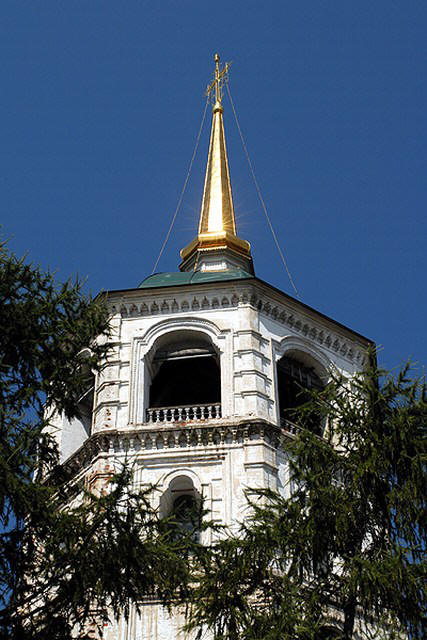
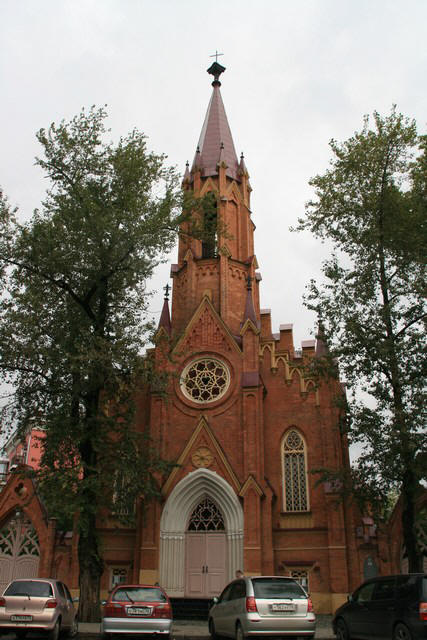
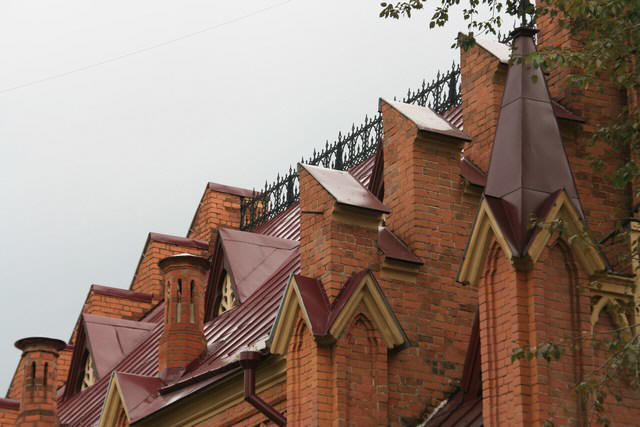
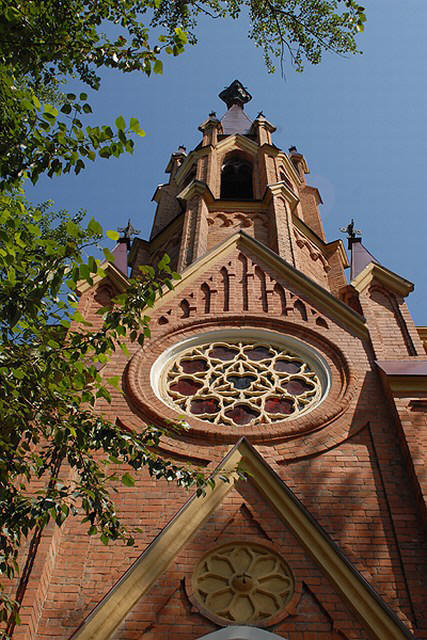

Decembrists in Irkutsk
On December 14, 1825, Lieutenant Panov and other leaders of the
uprising (mostly high-ranking officers) marched armed troops to Senate
Square in St.Petersburg to force the Senate to sign a manifesto deposing
the autocracy, abolishing serfdom, instituting democratic reforms, etc.
However, the uprising was suppressed because of indecision and wavering
on the part of its leaders. Five were executed. Others punished in
various ways: reduced to the ranks and sent to the Caucasus, a scene of
fierce fighting at the time, or deprived of all rights and estates and
sent into exile for life in Siberia. Among the places these exiles were
sent was the Irkutsk Province.
After the Amnesty of 1856, declared at the time of Alexander's ascension
to the throne, only forty-two of the exiles returned home. Those who did
were still banned from living in the two capital cities, St. Petersburg
and Moscow.
The first Decembrists came to Irkutsk in the summer of 1826. From
Irkutsk they were sent on to other places according to the terms of
their sentences: those sentenced to banishment went to remote,
thinly-populated areas of Eastern Siberia; those sentenced to hard
labour, to mines, factories, prisons and forts.
The houses in which some of them lived are now museums.
A particularly important role in the life of Irkutsk society was played
by S. G. Volkonsky (1788-1865), ex-major-general, veteran of the 1812
Patriotic War, and one of the leaders of Decembrist's Southern Society.
He was deported to a village near Irkutsk, where he tilled the fields
with the peasants, teaching them advanced farming methods. His house in
Irkutsk (which he designed himself), became a major centre of cultural
life. Amateur theatricals and concerts were given here, and debates were
conducted.
Piotr Mukhanov (1799-1854) was the staff-captain of the lzmailovsky
Life-Guards Regiment. He was a friend of the poet Alexander Pushkin, and
was himself a writer, author of novellas and vaudevilles and translator
of French comedies staged in Russia. Mukhanov studied at Moscow
University and then at the Column Leaders' School, which trained
officers for the General Staff. After the failure of the insurrection of
December 14, 1825, he was sentenced to twelve years of penal servitude,
which was reduced to eight years followed by exile for life in Siberia.
The wives and fiancées of some Decembrists came to Siberia to share the
lot of their men, overcoming the opposition of the authorities and of
their relatives, losing their rights and possessions, and travelling
thousands of kilometers by sledge and carriage. They were not allowed to
take their children with them, and were not always allowed to return to
the European part of Russia even after their husbands' death.

station of Irkutsk
Irkutsk today
Nowadays the city of Irkutsk is one of greatest economic and
cultural centers in the eastern part of the country. Many years ago the
modern stately city expanded and grew beyond its former outskirts. The
presence of an historic Polish Roman-Catholic church, a Tatar mosque,
and a Jewish synagogue show that from the very beginning the city was
multicultural and multinational.
Formerly cut off from central Russia by the rocky Urals, this distant
Siberian city is now connected by living threads with all the world. The
100th anniversary of the East-Siberian steamship-line was celebrated in
1985. There are direct routes connecting the city with Mongolia, Japan
and China, as well as many routes within the country.
Despite the fact that Irkutsk is well over three hundred years old, the
average age of today's population is only 31.6 years. It is a city of
youth and students. There are 36 institutes and colleges and 9
vocational schools. In 1949 the East-Siberian branch of the Russian
Academy of Science founded 9 research institutions and a regional
Economy Department.
Irkutsk is also a cultural city; there are five theatres and several
cinemas and libraries as well.

theatre
The
Trans-Siberian railroad
Trans-Siberian railway construction was held in difficult climate
conditions. Most of the road was build through low populated or not
populated areas with tense forests. The road goes across many strong
Siberian rivers, meets many lakes, swampy and permafrost areas on its
way (from Kuenga to Bochkarevo, now Belogorsk). The most difficult for
builders was the section around the Baikal (Baikal station - Mysovaya
station). Here they had to blast rocks, to make tunnels, to build
additional structures on the rivers that go into Baikal.

Class Cy, a highly successful passenger engine. 'S'
stands for Sormovo, where these steam locos were built from 1911.
Cy means that it is a strengthened C, developed from the C class and in
production from 1926 to 1951.
Trans-Siberian railway building required a lot of money. According to
the Railway Construction Committee calculations estimated costs of road
building were 350 millions of gold rubles. Therefore, to lower the costs
and to build the road faster Committee established special simplified
technical conditions base for the Ussuriysk and Western Siberia sections
of the road. For example, according to the Committee's recommendation
the width of the earth bed in such places as mounds and excavations was
decreased, ballast layer was made thinner, lighter rails were used, the
number of sleepers for 1 km was decreased, etc. Major construction works
were planned only for the big bridges. Smaller bridges were built of
wood. 50-verst distance between stations was allowed.
The sharpest problem was the problem of attracting labor for the
building of Trans-Siberian railway. The need for qualified workers was
satisfied by hiring workers in the center and by transporting them to
Siberia. Most of the builders were convicts and soldiers. Peasants from
Siberia, people from Siberian towns and also peasants and low middle
class people from European part of Russia were involved in construction
of Trans-Siberian railway as well. At the beginning of construction in
1891 the total number of workers on Trans-Siberian railway was 9600. In
1895 - 1896 it went up to 84000 - 89000 workers. On the final stage of
construction in 1904, there were only 5300 workers. The use of Siberian
exile for punishment of criminals and political offenders began almost
immediately after the conquest, but accelerated with the rise of the
Russian revolutionary movement in the 19th century.
The Trans-Siberian Railway greatly influenced the composition and size
of the population of Siberia.

More pictures of the transsib, click
HERE
Famous people
Nikolai Mikhailovich Przhevalsky (1839-88), Russian
geographer, traveler and researcher of Central Asia, Honorary Member of
St. Petersburg Academy of Sciences. Between 1867 and 1869 he headed an
expedition to the Ussuri area, and in 1870-73, to Mongolia, China and
Tibet. He determined the direction of the mountain ridges of Central
Asia and discovered, described and made vast collections of previously
unknown species of animals. His books include A Journey in the Ussuri
Area in 1867-69 (1870), and From Kuldzha to Tian Shan and Beyond
and to Lobnor (1878). His name was given to a town in Kirghizia, a
ridge in the mountain system of Kunlun, a glacier in Altal and many
other geographical landmarks and species of animals and plants
discovered by him. In 1891 the Russian Geographical Society established
a silver medal and a prize in his honour, and in 1946 the Przhevalsky
Gold Medal was instituted.

Przhevalsky horses in Mongolia
Nureyev, Rudolf Hametovich (1938-1993), Russian-born ballet
dancer and choreographer, perhaps the greatest virtuoso and most
charismatic male dancer of his generation. Born near Irkutsk, he became
a soloist with the Kirov Ballet (now the Saint Petersburg Ballet) in
1958. While on tour in 1961, Nureyev defected from the Union of Soviet
Socialist Republics. In 1962 he became associated with Britain's Royal
Ballet, where he was often paired with British ballerina Margot Fonteyn.
He was artistic director of the Paris Opera Ballet from 1983 to 1989.
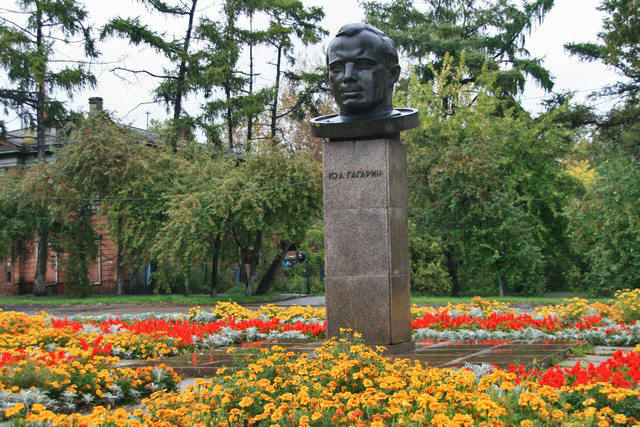
Statue of Yuri Gagarin (1934-1968), cosmonaut and first
man in space
Mme. Pola (1900-1983), Russian-born Fashion Designer
Born Appolinaria Petrovna Eroffeyevna near Irkutsk, Pola married
Vladimir Jaludsky circa 1918. Vladimir, a Military Officer, was killed
in the Russian Revolution shortly thereafter, and Pola left Russia with
their two small children. After residing briefly in China, Pola arrived
penniless in the United States in 1924. She worked as a seamstress in
factories for many years until she began designing for the house of
glamorous fashion designer Valentina. In 1937, Pola opened her own New
York Salon of Haute Couture Designs, which catered to the denizens of
Hollywood and High Society. Her creations were always
Russian-influenced, such as gowns with dolman sleeves, and they set
trends across America.
Her most famous design, the 1944 Inaugural Gown for First Lady Bess
Truman, wife of U.S. President Harry S. Truman, now stands on display at
The Smithsonian Institution's National Museum of American History in
Washington, D.C., USA.

The great wealth contributed greatly to the unique
character of Irkutsk architecture, because they asked the best
architects in Russia for creating houses. And it sometimes happened that
a talented architect left the first memories of himself in far Siberia
and only later gained fame in Moscow and St.Petersburg.
The whimsical brick house of the millionaire brothers Vtorov, who had
1500 employees and owned famous shops in many cities of Western Europe,
China, and Mongolia, was designed in Neorussian style. Today it still is
to be seen at the former Ivanovsaya Square. Another millionaire,
Trapeznikov, ordered his private residence to be built after the pattern
of the famous Louvre in Paris. And the great architect Qwarengi
considered it an honor to fulfill the order of the powerful merchant
Sibyryakov. Built from his design, the White House was called by
contemporaries "the Oriental Palace" because of its blinding richness.
Sukachyov - the mayor and founder of the Irkutsk art museum - built his
private residence, complete with an art gallery, in exotic oriental
style on the outskirts of the city. But after the big fire, Bolshaya
street, Amurskaya street and Laninskaya street became the architectural
showcase of the city, with buildings designed not only by celebrities
from the capital but also by talented local architects.
But the capital of East Siberia became not only famous because of its
brick buildings. The areas of the city where wooden buildings dominate
are equally beautiful, and there you can find a deeper national
heritage. The majority of Siberian cities are proud of their wood
architecture, but only in Irkutsk you can see the most artistic
handcrafted wooden elements.
Irkutsk is famous for its wooden architecture. Almost all of the wooden
houses are privately owned.
The newer ones, those of the 19th century have windows that
are similar to the windows of a palace in a Russian fairy-tale. The
ornaments were not only made for decorative purpose, they were also
symbolic. The symbols depicted different hopes, and dreams of the people
of that time. For example - people believed that evil spirits could
enter the dwelling through doors and windows frames. So the decorations
used in those parts of the house were for protection. The sign of the
sun could be outlined with jagged star shapes. It is obvious that this
symbolizes life, happiness, and the beginning of all good things. And
two pigeons with a bunch in their beaks are symbolic of a "Universe
tree". People believed that in the heavenly paradise there was a fairy
tree covering all of heaven with leaves and fruits of all the trees and
plants from all over the world. In this tree these pigeons lived.
Usually, five or six windows face the street. The windows are rather
big. Shutters are painted in blue and green. Blue and green are the
favorite colors in Siberia. Blue is a symbol of hope and green is for
long life and youth. White is symbolic of purification.
In Siberia, wooden houses are built in pine and cedar.


Lake
Baikal is the world's deepest lake. It is about 60 km (40 miles)
south-east of Irkutsk, and 1637 m (5371 ft) deep. It contains
about 20% of the world's freshwater supplies. It is not only the deepest,
but also the oldest lake in the world, formed almost 50 million years
ago.
Russian colonists called Baikal the 'Holy Sea' since there were so many
myths and legends about this place.
Emvironmental threats
The lake's remoteness kept it safe from environmental damage until the
building of the Trans-Siberian railway.
Baikal became a UNESCO World Heritage Site in 1996 and is ringed by
nature reserves. Today there are numerous gas and oil pipelines, that
pass near the shore on their way to China and the Sea of Japan. A
pipeline rupture could cause great damage to the lake.

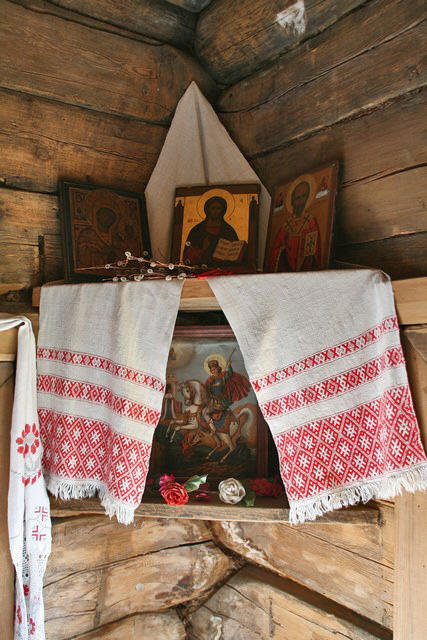
Open Air Museum
Red or beautiful corner of a house.
Getting to the lake.
Visitors can go from Irkutsk to the lake by boat or by bus. It is nice
to pay a visit to one of the museums, before getting on board. There is
a nice Open Air Museum with a collection of wooden houses, and a Baikal
Museum. At the Baikal Museum you can get an impression of the unique
marine life and animals in the Baikal area. It is rather interesting,
because about 80% of the species in Lake Baikal cannot be found anywhere
else in the world.


Angara river
Lake Baikal
Shaman Rock
In the stretch of water between the Baikal Museum and Port Baikal it's
possible to see a small part of a rock sticking out of the water.
According to local legend, Old Man Baikal had 336 sons (which is the
number of rivers that flow into the lake) and one daughter, the
beautiful Angara. She enraged her father, because she refused to marry
the feeble Irkut. She preferred the mighty Yenisey (Russia's longest
river). The old man chained her up, but one stormy night she
slipped her bonds and fled north to her lover. As her father discovered
this , he was furious. He hurled a huge boulder after her. She got away,
but the rock is still to be seen.


Lake
Baikal